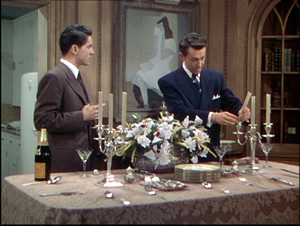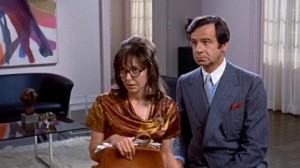 I’ve seen most of Alfred Hitchcock’s major films, but for some reason Rope had eluded me until last week, when it popped up on Turner Classic Movies as part of a Jimmy Stewart marathon. Like most cinephiles, I didn’t find it very impressive, though I was fascinated to see John Dall camping it up as one of the two gotta-be-gay murderers, having only recently watched his straight-down-the-center performance as the hapless bank robber-victim of Gun Crazy.
I’ve seen most of Alfred Hitchcock’s major films, but for some reason Rope had eluded me until last week, when it popped up on Turner Classic Movies as part of a Jimmy Stewart marathon. Like most cinephiles, I didn’t find it very impressive, though I was fascinated to see John Dall camping it up as one of the two gotta-be-gay murderers, having only recently watched his straight-down-the-center performance as the hapless bank robber-victim of Gun Crazy.
That said, one thing about Rope struck me quite forcibly. In fact, it astonished me. About ten minutes or so into the first reel, Hitchcock’s wandering camera came to rest in front of a painting hanging in the dining room of the elaborate breakaway set on which Rope was filmed. As Dall and Farley Granger chatted away, I said to myself, “By God, that’s a Milton Avery.” To be exact, it appears to be a portrait of March Avery, the artist’s daughter, painted some time in the mid-to-late Forties. What’s more, it looks like the real thing, not a reproduction. Rope dates from 1948, the same year that Avery made March at a Table, a copy of which hangs in the Teachout Museum. Hence it’s well within the realm of possibility that I saw exactly what I thought I saw.
 Why was I surprised? Because one rarely if ever runs across important modern American paintings in Hollywood movies. When a painting is seen in some millionaire’s living room, it’s almost always a fairly obvious copy of a French Impressionist or post-impressionist canvas. To be sure, I’ve spotted mock-Rothkos once or twice, nor is it uncommon to encounter Andy Warhol-type eye candy, but the only bonafide example of high American modernism that I can recall off the top of my head is the Morris Louis that hangs in Walter Matthau’s apartment in Elaine May’s A New Leaf. (It’s definitely the real thing—André Emmerich, Louis’ gallery, even gets screen credit.)
Why was I surprised? Because one rarely if ever runs across important modern American paintings in Hollywood movies. When a painting is seen in some millionaire’s living room, it’s almost always a fairly obvious copy of a French Impressionist or post-impressionist canvas. To be sure, I’ve spotted mock-Rothkos once or twice, nor is it uncommon to encounter Andy Warhol-type eye candy, but the only bonafide example of high American modernism that I can recall off the top of my head is the Morris Louis that hangs in Walter Matthau’s apartment in Elaine May’s A New Leaf. (It’s definitely the real thing—André Emmerich, Louis’ gallery, even gets screen credit.)
So what’s the story? Beats me, but given the fact that Hitchcock is known to have owned an Avery, I’d be surprised if it wasn’t that one. Would that I could tell you more, including what happened to the painting in question, but for now it must remain, appropriately enough, a mystery.
